DESCRIPTION Refer to DTC P0412 (See page
 ). ). |
DTC No. | DTC Detection Condition |
Trouble Area | |
P2440 | Cumulative pressure pulsation is 60 kPa (450 mmHg) or more for 2 seconds (1 trip detection logic). |
- Air switching valve (ASV) assembly
- Open or short in ASV circuit
- Secondary air injection system piping
- Pressure sensor
- Pressure sensor circuit
- Air injection control driver (AID)
- ECM
| | The air switching valve (for bank 1) is stuck open for 7 seconds while the engine is running (2 trip detection logic). | |
P2441 | The air switching valve (for bank 1) is stuck close for 7 seconds while the engine is running (2 trip detection logic). |
- Air switching valve (ASV) assembly
- Open or short in ASV circuit
- Vacuum hose (ASV - pressure sensor)
- Secondary air injection system piping
- Pressure sensor
- Pressure sensor circuit
- Air injection control driver (AID)
- Open or short in air pump heater circuit
- Air pump heater relay (AI HTR)
- Air pump assembly
- ECM
| | P2442 |
Cumulative pressure pulsation is 60 kPa (450 mmHg) or more for 2 seconds (1 trip detection logic). |
- Air switching valve (ASV) assembly
- Open or short in ASV circuit
- Secondary air injection system piping
- Pressure sensor
- Pressure sensor circuit
- Air injection control driver (AID)
- ECM
| | The air switching valve (for bank 2) is stuck open for 7 seconds while the engine is running (2 trip detection logic). | |
P2443 | The air switching valve (for bank 2) is stuck close for 7 seconds while the engine is running (2 trip detection logic). |
- Air switching valve (ASV) assembly
- Open or short in ASV circuit
- Vacuum hose (ASV - pressure sensor)
- Secondary air injection system piping
- Pressure sensor
- Pressure sensor circuit
- Air injection control driver (AID)
- Open or short in air pump heater circuit
- Air pump heater relay (AI HTR)
- Air pump assembly
- ECM
| HINT: Air switching valve normal operation:
When the Air Switching Valve (ASV) is open, exhaust gas pulsation occurs in the secondary air passage.
When the ASV is closed, exhaust gas pulsation does not occur in the secondary air passage. MONITOR DESCRIPTION
The
ECM monitors the pressure in the secondary air passage using the
pressure sensor connected to the ASV of the Secondary Air Injection
(AIR) system. If either of the following
conditions occurs, the ECM interprets it as a malfunction of the AIR
system, and illuminates the MIL and stores a DTC:
- Exhaust gas pulsation is detected by the pressure sensor despite the ECM commanding the ASV to close.
- Exhaust gas pulsation is not detected by the pressure sensor despite the ECM commanding the ASV to open.
MONITOR STRATEGY |
Related DTCs | P2440: Air control valve stuck open
P2441: Air control valve stuck closed P2442: Air control valve stuck open
P2443: Air control valve stuck closed | |
Required Sensors/Components (Main) | Pressure sensor | |
Required Sensors/Components (Related) |
- | | Frequency of Operation |
Continuous: P2440 Case 2, P2442 Case 2 Once per drive cycle: Others | |
Duration | 2 seconds: P2440 Case 2, P2442 Case 2
7 seconds: Others | | MIL Operation |
1 driving cycle: P2440, P2442 2 driving cycles: Others | |
Sequence of Operation | None | TYPICAL ENABLING CONDITIONS All |
Monitor runs whenever following DTCs not present |
P0010, P0020 (VVT oil control valve) P0011, P0021 (VVT system - Advance)
P0012, P0022 (VVT system - Retard) P0013, P0023 (Exhaust VVT oil control valve)
P0014, P0024 (Exhaust VVT system - Advance) P0015, P0025 (Exhaust VVT system - Retard)
P0016, P0018 (VVT system - Misalignment) P0017, P0019 (Exhaust VVT system - Misalignment)
P0031, P0032, P0051, P0052, P101D, P103D (Air fuel ratio sensor heater)
P006A, P0107, P0108 (Manifold absolute pressure) P0102, P0103 (Mass air flow meter)
P0112, P0113 (Intake air temperature sensor) P0115, P0117, P0118 (Engine coolant temperature sensor)
P0120, P0121, P0122, P0123, P0220, P0222, P0223, P2135 (Throttle position sensor)
P0125 (Insufficient Coolant Temperature for Closed Loop Fuel Control)
P014C,
P014D, P014E, P014F, P015A, P015B, P015C, P015D, P2195, P2196, P2197,
P2198, P2237, P2238, P2239, P2240, P2241, P2242, P2252, P2253, P2255,
P2256 (Air fuel ratio sensor) P0171, P0172, P0174, P0175 (Fuel system)
P0301 - P0308 (Misfire) P0327, P0328, P032C, P032D, P0332, P0333, P033C, P033D (Knock Sensor)
P0335 (Crankshaft position sensor) P0340, P0342, P0343, P0345, P0347, P0348 (VVT sensor)
P1340 (Camshaft position sensor) P0351 - P0358 (Igniter) P0365, P0367, P0368, P0390, P0392, P0393 (Exhaust VVT sensor)
P0401 (EGR system) P0451, P0452, P0453 (Evaporative Emission System Pressure Sensor)
P0500 (Vehicle speed sensor) P106B (Evap. emission control system Pressure Sensor - Air Injection System Pressure Sensor correlation)
P219A, P219B, P219C, P219D, P219E, P219F, P21A0, P21A1, P21A2, P21A3 (Air-fuel ratio imbalance)
P2431, P2432, P2433, P2436, P2437, P2438 (Secondary Air Injection System Pressure Sensor) | P2440 (Case 1), P2441, P2442 (Case 1), P2443 |
Battery voltage | 11 V or more | |
Atmospheric pressure | 45 kPa (338 mmHg) or more | |
Engine | Running | |
AIR monitor during AIR: ON*1 | Completed | |
AIR monitor during AIR: OFF*2 | Completed | |
AIR injection driver fail (open/short or out of range) |
Not detected | | AIR pressure sensor fail (open/short or out of range) |
Not detected | |
*1: AIR monitor during AIR: ON | - | |
Time after AIR in operation | 5 seconds or more | |
AIR pump | ON | | AIR valve |
Open | | Engine speed | 400 to 3750 rpm | |
Intake air amount | Less than 100 gm/s | |
Time after engine start | 1 second or more | |
*2: AIR monitor during AIR: OFF | - | |
Time after AIR in operation | 10 seconds or more | |
AIR pump | OFF | | AIR valve |
Close | | Engine speed | Below 3000 rpm | |
AIR monitor during AIR: ON | Completed | |
Time after engine start | 1 second or more | P2440, P2442 AIR valve is stuck open (Case 2) |
One of the following conditions is met | (a), (b) or (c) | |
(a) Cumulative intake air amount | 100 gm/s or more | |
(b) Difference between starting temperature and current temperature |
10°C (18°F) or higher | | (c) Starting coolant temperature |
60°C (140°F) or higher | | AIR pump |
OFF | | AIR valve |
Close | | Engine speed |
3750 rpm or less | | AIR pressure sensor fail (open/short or out of range) |
Not detected | | Time after engine started |
1 second or more | | Time after AIR in operation |
10 seconds or more | | AIR valve open stuck |
Not detected | | AIR pressure sensor open stuck (DTC P2445, P2447) |
Not in operation | | Engine load |
20% or more | TYPICAL MALFUNCTION THRESHOLDS Secondary Air Injection ON (Condition 1) |
Both conditions are met during AIR ON | - | |
Cumulative pressure pulsation | 18 kPa or higher | |
AIR pressure | 1.9 kPa or higher | Secondary Air Injection ON (Condition 2) |
Both conditions are met during AIR ON | - | |
Cumulative pressure pulsation | 18 kPa or higher | |
AIR pressure | Below 1.9 kPa | Secondary Air Injection ON (Condition 3) |
Both conditions are met during AIR ON | - | |
Cumulative pressure pulsation | Below 18 kPa | |
AIR pressure | 1.9 kPa or higher | Secondary Air Injection ON (Condition 4) |
Both conditions are met during AIR ON | - | |
Cumulative pressure pulsation | Below 18 kPa | |
AIR pressure | Below 1.9 kPa | Secondary Air Injection OFF (Condition 1) |
Both conditions are met during AIR OFF | - | |
Cumulative pressure pulsation | 25 kPa or higher | |
AIR pressure | 3 kPa or higher | Secondary Air Injection OFF (Condition 2) |
Both conditions are met during AIR OFF | - | |
Cumulative pressure pulsation | 25 kPa or higher | |
AIR pressure | Below 3 kPa | Secondary Air Injection OFF (Condition 3) |
Both conditions are met during AIR OFF | - | |
Cumulative pressure pulsation | Below 25 kPa | |
AIR pressure | 3 kPa or higher | Secondary Air Injection OFF (Condition 4) |
Both conditions are met during AIR OFF | - | |
Cumulative pressure pulsation | Below 25 kPa | |
AIR pressure | Below 3 kPa | P2440, P2442 AIR valve is stuck open (Case 1) |
Either condition is met | (a) or (b) | |
(a) AIR OFF Condition 1 | Met | |
(b) AIR OFF Condition 2 | Met | P2441, P2443 AIR valve is stuck closed |
Either condition is met | (a) or (b) | |
(a) AIR ON Condition 3 | Met | |
(b) AIR ON Condition 4 | Met | P2440, P2442 AIR valve is stuck open (Case 2) |
Cumulative pressure pulsation | 75 kPa or higher | MONITOR RESULT
Refer to Checking Monitor Status (See page  ). ). CONFIRMATION DRIVING PATTERN
NOTICE:
- This Secondary Air Injection Check only allows technicians to operate the AIR system for a maximum of 5 seconds.
Furthermore, the check can only be performed up to 4
times per trip. If the test is repeated, intervals of at least 30
seconds are required between checks.
While AIR system operation using the Techstream is prohibited, the Techstream display indicates the prohibition (WAIT or ERROR).
If ERROR is displayed on the Techstream during the test, stop the engine for 10 minutes, and then try again.
- Performing the Secondary Air Injection Check repeatedly may cause damage
to the AIR system. If necessary, leave an interval of several minutes
between System Check operations to prevent the system from overheating.
- When performing the Secondary Air Injection Check operation after the
battery cable has been reconnected, wait for 7 minutes with the ignition
switch turned to ON or the engine running.
- Turn the ignition switch off when the Secondary Air Injection Check operation finishes.
- Start the engine and warm it up.
- Turn the ignition switch off.
- Connect the Techstream to the DLC3.
- Turn the ignition switch to ON.
- Turn the Techstream on.
- Clear DTCs (if set) (See page
 ). ).
- Turn the ignition switch off and wait for at least 30 seconds.
- Turn the ignition switch to ON and turn the Techstream on.
- Enter the following menus: Powertrain / Engine and ECT / Utility / Secondary Air Injection Check / Automatic Mode.
- Start the engine after the Techstream initialization is finished.
- Perform the System Check operation by pressing ENTER (Next).
- Perform the following to confirm the AIR system pending codes: Press ENTER (Exit).
- Check for pending DTCs.
OK:
No pending DTC is output.
- After the "Secondary air injection check" is completed, check for All
Readiness by entering the following menus: Powertrain / Engine and ECT /
Utility / All Readiness.
- Input the DTC: P2440, P2441, P2442 or P2443.
- Check the DTC judgment result.
|
Tester Display |
Description |
|
NORMAL |
- DTC judgment completed
- System normal
|
|
ABNORMAL |
- DTC judgment completed
- System abnormal
|
|
INCOMPLETE |
- DTC judgment not completed
- Perform driving pattern after confirming DTC enabling conditions
|
|
N/A |
- Unable to perform DTC judgment
- Number of DTCs which do not fulfill DTC preconditions has reached ECU memory limit
|
HINT:
- If the judgment result shows NORMAL, the system is normal.
- If the judgment result shows ABNORMAL, the system has a malfunction.
- If the test result is INCOMPLETE or N/A and no pending DTC is output,
perform a universal trip and check for permanent DTCs (See page
 ). ).
HINT:
- If no permanent DTC is output, the system is normal.
- If a permanent DTC is output, the system is malfunctioning.
- Turn the ignition switch off.
WIRING DIAGRAM Refer to DTC P0412 (See page
 ). ). CAUTION / NOTICE / HINT
HINT:
HINT: Determination by ECM monitoring: The
ECM locates malfunctions in the Secondary Air Injection (AIR) system by
detecting the pressure in the AIR passage between the air pump and Air
Switching Valve (ASV) and stores a DTC. Soon after a cold engine start,
the monitor runs for a short time while the AIR system is both ON and
OFF. The ECM detects both the pressure and the exhaust pulsation and
compares them. The following 8 patterns are AIR system pressure conditions in the AIR system passage. Pressure Condition in Secondary Air Injection System Case 1 |
Air Pump | ON | |
Air Switching Valve | Open | |
Pressure | 1.9 kPa or more | |
Pulsation Detection | Exhaust gas pulsation detected | Pressure Condition in Secondary Air Injection System Case 2 |
Air Pump | OFF | |
Air Switching Valve | Open | |
Pressure | Less than 3.0 kPa | |
Pulsation Detection | Exhaust gas pulsation detected | Pressure Condition in Secondary Air Injection System Case 3 |
Air Pump | ON | |
Air Switching Valve | Closed | |
Pressure | 1.9 kPa or more | |
Pulsation Detection | Exhaust gas pulsation not detected | Pressure Condition in Secondary Air Injection System Case 4 |
Air Pump | OFF | |
Air Switching Valve | Closed | |
Pressure | Less than 3.0 kPa | |
Pulsation Detection | Exhaust gas pulsation not detected | Pressure Condition in Secondary Air Injection System Case 5 |
Air Pump | ON | |
Air Switching Valve | Open | |
Pressure | 1.9 kPa or more | |
Pulsation Detection | Exhaust gas pulsation detected | Pressure Condition in Secondary Air Injection System Case 6 |
Air Pump | OFF | |
Air Switching Valve | Open | |
Pressure | Less than 3.0 kPa | |
Pulsation Detection | Exhaust gas pulsation detected | Pressure Condition in Secondary Air Injection System Case 7 |
Air Pump | ON | |
Air Switching Valve | Closed | |
Pressure | 1.9 kPa or more | |
Pulsation Detection | Exhaust gas pulsation not detected | Pressure Condition in Secondary Air Injection System Case 8 |
Air Pump | OFF | |
Air Switching Valve | Closed | |
Pressure | Less than 3.0 kPa | |
Pulsation Detection | Exhaust gas pulsation not detected |
If
the detected pressure is high, the air pump is assumed to be ON and if
it alternates sharply, the ASV is assumed to be open. The ECM locates
malfunctions from the combination of pressures detected when the AIR
system is ON and OFF. HINT: The
exhaust pulsation value is calculated in the ECM. If the calculated
value exceeds a certain level, the ECM determines that the exhaust
pulsation is in the AIR system.
HINT:
- In case 3 and 7, as the pressure sensor detects a slight pump operation
pulsation, the detected value is not constant. Since the pump outlet is
blocked by closing the ASV, the average pressure is higher than in case 1
(approximately 18 to 25 kPa).
- In case 1, the average pressure is approximately 3 to 11 kPa. The value
of 1.9 kPa indicated in the table above is a threshold for detecting
pump malfunctions.
|
Detected Condition while AIR Operating: Air Pump ON, ASV Open |
Detected Condition while AIR not Operating: Air Pump OFF, ASV Closed |
ECM Determination | DTC Output | |
Case 1 | Case 8 |
Normal | - | |
Case 1 | Case 6 |
Air switching valve stuck open |
P2440 or P2442 | |
Case 1 | Case 7 |
Air pump stuck ON | P2444
or P2446 | |
Case 2 | Case 8 |
Air pump stuck OFF | P2445
or P2447 | |
Case 3 | Case 8 |
Air switching valve stuck closed |
P2441 or P2443 | |
Case 1 | Case 5 |
Air switching valve stuck open and air pump stuck ON |
P2440 and P2444 or P2442 and P2446 | |
Case 2 | Case 6 |
Air switching valve stuck open and air pump stuck OFF |
P2440 and P2445 or P2442 and P2447 | |
Case 3 | Case 7 |
Air switching valve stuck closed and air pump stuck ON |
P2441 and P2444 or P2443 and P2446 | |
Case 4 | Case 8 |
Air switching valve stuck closed and air pump stuck OFF |
P2441 and P2445 or P2443 and P2447 |
HINT:
- By using the Techstream to perform the Secondary Air Injection Check
operation in the System Check, the air-fuel ratio and the pressure in
the secondary air injection system passage can be checked while the
secondary air injection system is operating. This helps technicians to
troubleshoot the system when it malfunctions. Furthermore, pending codes
also can be checked by performing Utility / Secondary Air Injection
Check / Automatic Mode after the repair.
- Read freeze frame data using the Techstream. Freeze frame data records
the engine condition when malfunctions are detected. When
troubleshooting, freeze frame data can help determine if the vehicle was
moving or stationary, if the engine was warmed up or not, if the
air-fuel ratio was lean or rich, and other data from the time the
malfunction occurred.
- System Check:
- The pressure in the secondary air passage can be checked using the Techstream.
- Start the engine and warm it up.
- Turn the ignition switch off.
- Connect the Techstream to the DLC3.
- Turn the ignition switch to ON.
- Turn the Techstream on.
- Enter the following menus: Powertrain / Engine and ECT / Utility /
Secondary Air Injection Check / Manual Mode / AIR PUMP 1: ON, ASV1:
OPEN, AIR PUMP 2: ON, ASV2: OPEN and AIR PUMP 1: OFF, ASV1 CLOSE, AIR
PUMP 2: OFF, ASV2 CLOSE.
HINT:
When
Manual Mode is selected, the Techstream initialization (atmospheric
pressure measurement) is performed automatically. The initialization
takes 10 seconds. After the initialization, AIR PUMP and ASV operation
can be selected.
- Start the engine.
- Perform the AIR system forced operation while the engine is idling.
- Check that the air pump (AIR PUMP), ASV and pressure in the AIR system
passage (PRESSURE) displayed on the Techstream indicate the conditions
shown in the table below.
Standard:
|
Tester Operation |
Air Pump |
ASV |
Pressure*1 |
Pulsation*2 |
|
AIR PUMP: ON, ASV: OPEN |
ON |
OPEN |
1.9 kPa or more |
18 kPa or more |
|
AIR PUMP: OFF, ASV: CLOSE |
OFF |
CLOSE |
Less than 3.0 kPa |
Less than 25 kPa |
*1: Average pumping pressure (gauge pressure). The pressure should be 1.9 kPa or more when the AIR system operates.
*2:
The cumulative exhaust pulsation calculated by the ECM. If the
calculated value exceeds a certain level, the ECM determines that the
exhaust pulsation is in the AIR system.
- Turn the ignition switch off.
NOTICE:
- This Secondary Air Injection Check only allows technicians to operate the AIR system for a maximum of 5 seconds.
Furthermore, the check can only be performed up to 4
times per trip. If the test is repeated, intervals of at least 30
seconds are required between checks.
While AIR system operation using the Techstream is prohibited, the Techstream display indicates the prohibition (WAIT or ERROR).
If ERROR is displayed on the Techstream during the test, stop the engine for 10 minutes, and then try again.
- Performing the Secondary Air Injection Check repeatedly may cause damage
to the AIR system. If necessary, leave an interval of several minutes
between System Check operations to prevent the system from overheating.
- When performing the Secondary Air Injection Check operation after the
battery cable has been reconnected, wait for 7 minutes with the ignition
switch turned to ON or the engine running.
- Turn the ignition switch off when the Secondary Air Injection Check operation finishes.
PROCEDURE |
1. | CHECK ANY OTHER DTCS OUTPUT (IN ADDITION TO SECONDARY AIR INJECTION SYSTEM DTCS) |
(a) Connect the Techstream to the DLC3. (b) Turn the ignition switch to ON.
(c) Turn the Techstream on. (d) Enter the following menus: Powertrain / Engine and ECT / Trouble Codes.
(e) Read DTCs. Result |
Result | Proceed to | |
P2440, P2441, P2442 and/or P2443 is output |
A | | P2440, P2441, P2442 and/or P2443 and P0412 and/or P0415 are output |
B | | P2440, P2441, P2442 and/or P2443 and other DTCs (except P0412 and P0415) are output |
C | If any DTCs other than P0412, P0415, P2440, P2441, P2442 and/or P2443 are output, troubleshoot those DTCs first.
| B |
 | GO TO AIR SWITCHING VALVE ASSEMBLY INSPECTION PROCEDURE (P0412 AND P0415) |
| C |
 | GO TO DTC CHART |
|
A |
 | |
| 2. |
PERFORM ACTIVE TEST USING TECHSTREAM (ACTIVATE THE AIR PUMP HEATER) |
| (a) Disconnect the air pump assembly (for bank 1 or Bank 2) connector. |
|
(b) Connect the Techstream to the DLC3. (c) Turn the ignition switch to ON and turn the Techstream on.
(d) Enter the following menus: Powertrain / Engine and ECT/ Active Test / Activate the Air Pump Heater.
(e) Measure the voltage according to the value(s) in the table below. Standard Voltage |
Tester Connection | Condition |
Specified Condition | |
D89-1 (APH+) - Body ground |
Activate the Air Pump Heater is ON |
11 to 14 V | |
D90-1 (APH+) - Body ground |
Activate the Air Pump Heater is ON |
11 to 14 V | (f) Reconnect the air pump assembly (for bank 1 or Bank 2) connector.
| NG |
 | GO TO STEP 4 |
|
OK |
 | |
| 3. |
INSPECT AIR PUMP ASSEMBLY (FOR BANK 1 OR BANK 2) (HEATER RESISTANCE) |
(a) Inspect the air pump assembly (for bank 1 or bank 2) (See page
 ). ).
| NG |  |
REPLACE AIR PUMP ASSEMBLY (FOR BANK 1 OR BANK 2) |
|
OK |
 | |
| 4. |
INSPECT AIR PUMP HEATER (AI HTR) RELAY |

| NG |  |
REPLACE AIR PUMP HEATER (AI-HTR) RELAY |
|
OK |
 | |
| 5. |
CHECK AIR PUMP HEATER (AI HTR) RELAY (POWER SOURCE) |
(a) Remove the air pump heater (AI HTR) relay.
| (b) Measure the voltage according to the value(s) in the table below. Standard Voltage |
Tester Connection | Condition |
Specified Condition | |
AI HTR relay terminal 5 - Body ground |
Always | 11 to 14 V | |
|
(c) Reinstall the air pump heater (AI-HTR) relay.
| NG |
 | REPAIR OR REPLACE HARNESS OR CONNECTOR |
|
OK |
 | |
| 6. |
CHECK HARNESS AND CONNECTOR (AIR PUMP ASSEMBLY - AI HTR RELAY, BODYGROUND) |
(a) Remove the air pump heater (AI HTR) relay. (b) Disconnect the air pump assembly (for bank 1 or bank 2) connector.
(c) Measure the resistance according to the value(s) in the table below. Standard Resistance |
Tester Connection | Condition |
Specified Condition | |
AI HTR relay terminal 3 - D89-1 (APH+) |
Always | Below 1 Ω | |
AI HTR relay terminal 3 - D90-1 (APH+) |
Always | Below 1 Ω | |
D89-3 (APHG) - Body ground |
Always | Below 1 Ω | |
D90-3 (APHG) - Body ground |
Always | Below 1 Ω | |
AI HTR relay terminal 3 or D89-1 (APH+) - Body ground |
Always | 10 kΩ or higher | |
AI HTR relay terminal 3 or D90-1 (APH+) - Body ground |
Always | 10 kΩ or higher |
(d) Reinstall the air pump heater (AI HTR) relay. (e) Reconnect the air pump assembly (for bank 1 or bank 2) connector.
| NG |
 | REPAIR OR REPLACE HARNESS OR CONNECTOR |
|
OK |
 | |
| 7. |
INSPECT AIR PUMP ASSEMBLY (FOR BANK 1 OR BANK 2) |
(a) Inspect the air pump assembly (for bank 1 or bank 2) (See page
 ). ).
| NG |  |
REPLACE AIR PUMP ASSEMBLY (FOR BANK 1 OR BANK 2) |
|
OK |
 | |
| 8. |
PERFORM ACTIVE TEST USING TECHSTREAM (SECONDARY AIR INJECTION SYSTEM OPERATION) |
(a) Visual check: (1) Start the engine and warm it up.
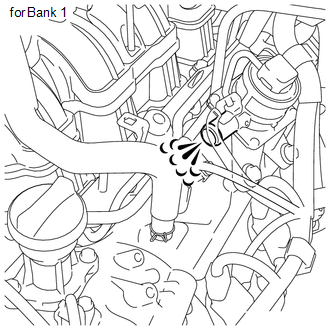
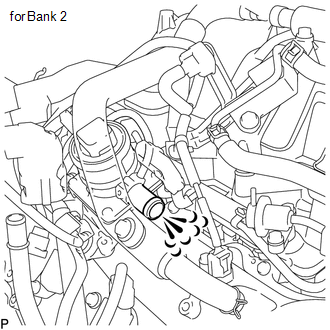 (2) Turn the ignition switch off.
(3) Disconnect the No. 1 air hose. (4) Connect the Techstream to the DLC3.
(5) Turn the ignition switch to ON. (6) Turn the Techstream on.
(7)
Enter the following menus: Powertrain / Engine and ECT / Utility /
Secondary Air Injection Check / Manual Mode / AIR PUMP 1: ON, ASV1:
OPEN, AIR PUMP 2: ON, ASV2: OPEN. HINT: When
Manual Mode is selected, the Techstream initialization (atmospheric
pressure measurement) is performed automatically. The initialization
takes 10 seconds. After the initialization, AP and ASV operation can be
selected. (8) Start the engine. (9) Perform the AIR system forced operation while the engine is idling.
(10)
Place your hand near the air switching valve port and check that the
exhaust gas pressure pulsates when the ASV is turned ON. CAUTION: To avoid the danger of being burned by the exhaust gas, bring your hand close to the valve port slowly.
(11)
Enter the following menus: Powertrain / Engine and ECT / Utility /
Secondary Air Injection Check / Manual Mode / AIR PUMP 1: ON, ASV1:
OPEN, AIR PUMP 2: ON, ASV2: OPEN and AIR PUMP 1: ON, ASV1: CLOSE, AIR
PUMP 2: ON, ASV2: CLOSE. (12) Check that the exhaust gas does not pulsate when the ASV is turned OFF.
(13) Turn the ignition switch off.
NOTICE:
- This Secondary Air Injection Check only allows technicians to operate
the AIR system for a maximum of 5 seconds. Furthermore, the check can
only be performed up to 4 times per trip. If the test is repeated,
intervals of at least 30 seconds are required between checks.
While AIR system operation using the Techstream is prohibited, the Techstream display indicates the prohibition (WAIT or ERROR).
If ERROR is displayed on the Techstream during the test, stop the engine for 10 minutes, and then try again.
- Performing the Secondary Air Injection Check repeatedly may cause damage
to the AIR system. If necessary, leave an interval of several minutes
between System Check operations to prevent the system from overheating.
- When performing the Secondary Air Injection Check operation after the
battery cable has been reconnected, wait for 7 minutes with the ignition
switch turned to ON or the engine running.
- Turn the ignition switch off when the Secondary Air Injection Check operation finishes.
OK: |
Air Pump Operation | ASV Operation |
Exhaust Gas Pulsation | |
ON | OFF |
Not detected | |
ON | ON |
Detected | (b) Other inspection method:
The ASV operation can be confirmed by checking the cumulative pressure pulsation* provided in the System Check.
Perform System Check operation under Manual Mode. *:
The exhaust pulsation value is calculated in the ECM. If the calculated
value exceeds a certain level, the ECM determines that the exhaust
pulsation is in the AIR system. (1) Start the engine and warm it up.
(2) Turn the ignition switch off. (3) Connect the Techstream to the DLC3.
(4) Turn the ignition switch to ON. (5) Turn the Techstream on.
(6)
Enter the following menus: Powertrain / Engine and ECT / Utility /
Secondary Air Injection Check / Manual Mode / AIR PUMP 1: ON, ASV1:
OPEN, AIR PUMP 2: ON, ASV2: OPEN and AIR PUMP 1: OFF, ASV1: CLOSE, AIR
PUMP 2: OFF, ASV2: CLOSE. (7) Start the engine after the Techstream initialization is finished.
(8) Perform the AIR system forced operation while the engine is idling.
(9)
Check that the air-fuel ratio and pressure in the secondary air
injection system passage (PULSATION) displayed on the Techstream
indicate the conditions shown in the table below. (10) Turn the ignition switch off.
OK: |
AIR System Operation | Pulsation Condition
(ECM Calculation) | Air-Fuel Ratio
(Reference) | | AIR PUMP: ON, ASV: OPEN |
18 kPa or more | 18 or more | |
AIR PUMP: OFF, ASV: CLOSE |
Less than 25 kPa | Approximately 14.5
(around stoichiometric air-fuel ratio) |
Reference: If the air pump operation is confirmed as normal (See page
 ), the air-fuel ratio detected in front of the three-way catalytic
converter changes in response to the secondary air pumped into the
exhaust port when the air pump operates.
), the air-fuel ratio detected in front of the three-way catalytic
converter changes in response to the secondary air pumped into the
exhaust port when the air pump operates. Result |
Result | Proceed to | |
NG | A | |
OK | B |
| B |
 | GO TO STEP 16 |
|
A |
 | |
| 9. |
INSPECT AIR TUBE (BLOCKAGE AND LEAK) |
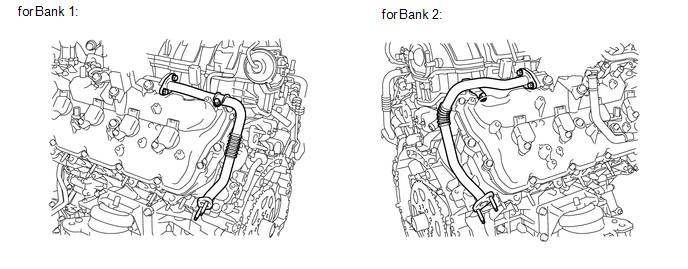 (a)
Check that the No. 2 and No. 3 air tubes are securely connected to both
the exhaust manifold and the air switching valve assembly. (b) Inspect the air tube for blockages and damage.
OK: No blockages in or damage to air tubes.
| NG |
 | REPLACE AIR TUBE |
|
OK |
 | |
| 10. |
INSPECT AIR SWITCHING VALVE ASSEMBLY (FOR BANK 1 OR BANK 2) |
(a) Inspect the air switching valve (for bank 1) (See page
 ). ). (b) Inspect the air switching valve (for bank 2) (See page
 ). ). Result |
Result | Proceed to | |
OK | A | |
NG (for Bank 1) | B | |
NG (for Bank 2) | C |
| B |
 | REPLACE AIR SWITCHING VALVE ASSEMBLY (FOR BANK 1) |
| C |
 | REPLACE AIR SWITCHING VALVE ASSEMBLY (FOR BANK 2) |
|
A |
 | |
| 11. |
INSPECT AIR INJECTION CONTROL DRIVER (POWER SOURCE OF AIR INJECTION CONTROL DRIVER) |
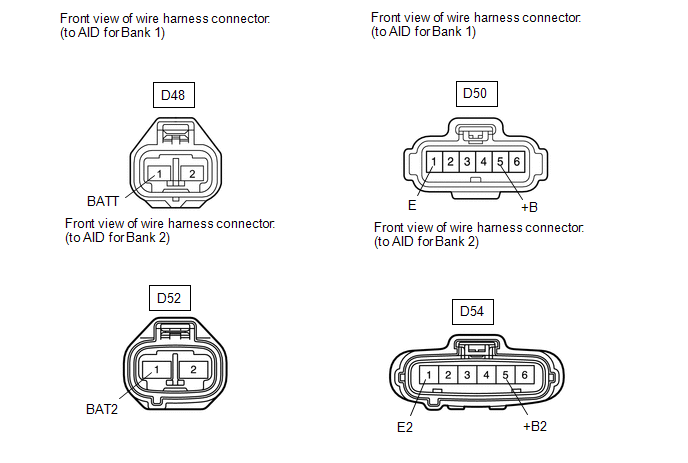 (a) Disconnect the air injection control driver (AID) (for bank 1 or bank 2) connectors.
(b) Turn the ignition switch to ON. (c) Measure the voltage according to the value(s) in the table below.
Standard Voltage: |
Tester Connection | Switch Condition |
Specified Condition | |
D48-1 (BATT) - Body ground |
Always | 11 to 14 V (near battery voltage) | |
D50-5 (+B) - Body ground |
Ignition switch ON | 11 to 14 V (near battery voltage) | |
D52-1 (BAT2) - Body ground |
Always | 11 to 14 V (near battery voltage) | |
D54-5 (+B2) - Body ground |
Ignition switch ON | 11 to 14 V (near battery voltage) |
(d) Measure the resistance according to the value(s) in the table below.
Standard Resistance: |
Tester Connection | Condition |
Specified Condition | |
D50-1 (E) - Body ground |
Always | Below 1 Ω | |
D54-1 (E2) - Body ground |
Always | Below 1 Ω |
| NG |
 | REPAIR OR REPLACE AIR INJECTION CONTROL DRIVER POWER SOURCE CIRCUIT |
|
OK |
 | |
| 12. |
CHECK HARNESS AND CONNECTOR (ECM - AIR INJECTION CONTROL DRIVER) |
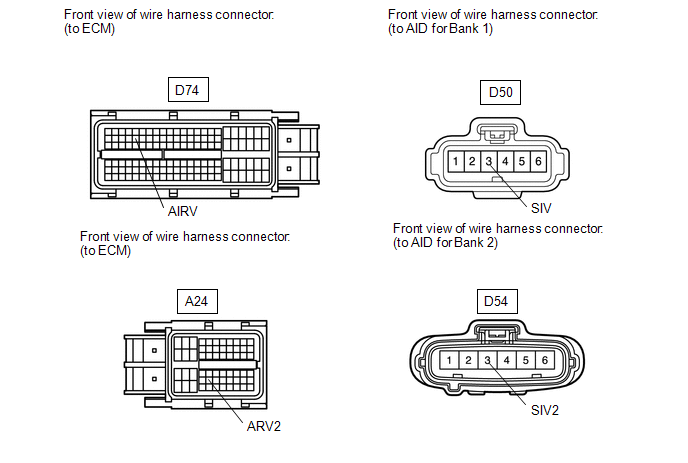 (a) Disconnect the ECM connectors.
(b) Disconnect the air injection control driver (AID) (for bank 1 or bank 2) connectors.
(c) Measure the resistance according to the value(s) in the table below.
Standard Resistance: |
Tester Connection | Condition |
Specified Condition | |
D74-28 (AIRV) - D50-3 (SIV) |
Always | Below 1 Ω | |
A24-43 (ARV2) - D54-3 (SIV2) |
Always | Below 1 Ω | |
D74-28 (AIRV) or D50-3 (SIV) - Body ground |
Always | 10 kΩ or higher | |
A24-43 (ARV2) or D54-3 (SIV2) - Body ground |
Always | 10 kΩ or higher |
| NG |
 | REPAIR OR REPLACE HARNESS OR CONNECTOR |
|
OK |
 | |
| 13. |
PERFORM ACTIVE TEST USING TECHSTREAM | (a) Disconnect the air injection control driver (AID) (for bank 1 or bank 2) connector.
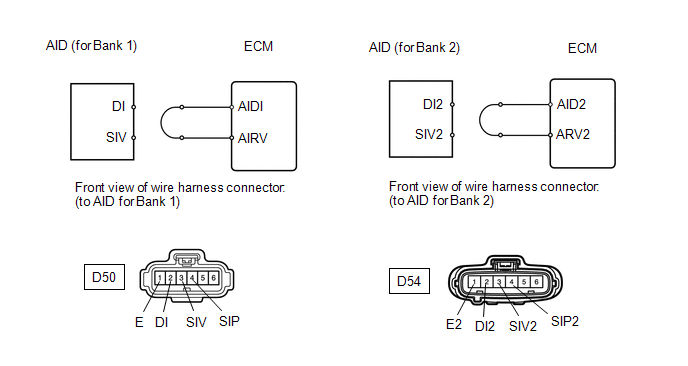 (b) Connect terminals DI and SIV or DI2 and SIV2 of the wire harness connector for the AID.
(c) Connect the Techstream to the DLC3. (d) Turn the ignition switch to ON and turn the Techstream on.
(e)
Enter the following menus: Powertrain / Engine and ECT / Utility /
Secondary Air Injection Check / Manual Mode / AIR PUMP 1: ON, ASV 1:
OPEN, AIR PUMP 2: ON, ASV 2: OPEN. HINT: When
Manual Mode is selected, the Techstream initialization (atmospheric
pressure measurement) is performed automatically. The initialization
takes 10 seconds. After the initialization, AIR PUMP and ASV operation
can be selected. (f) Start the engine. (g) Perform the AIR system forced operation while the engine is idling.
(h) Measure the voltage between the SIV and E or SIV2 and E2 terminals of the ECM connector when the AIR system is ON and OFF.
(i) Turn the ignition switch off.
NOTICE:
- Performing Secondary Air Injection Check repeatedly may cause damage to
the secondary air injection system. If it is necessary to repeat the
check, leave an interval of several minutes between System Check
operations to prevent the system from overheating.
- When performing the Secondary Air Injection Check operation after the
battery cable has been reconnected, wait for 7 minutes with the ignition
switch ON or the engine running.
- Turn the ignition switch off when the Secondary Air Injection Check operation finishes.
Standard Voltage: |
Tester Connection | Condition |
Specified Condition | | D50-3 (SIV) - D50-1 (E) |
AIR PUMP: ON, ASV: OPEN | 0.5 to 2 V | |
D54-3 (SIV2) - D54-1 (E2) | AIR PUMP: ON, ASV: OPEN |
0.5 to 2 V | | D50-3 (SIV) - D50-1 (E) |
AIR PUMP: OFF, ASV: CLOSE | 11 to 14 V | |
D54-3 (SIV2) - D54-1 (E2) | AIR PUMP: OFF, ASV: CLOSE |
11 to 14 V | (j) Connect terminals DI and SIP or DI2 and SIP2 of the wire harness connector for the AID.
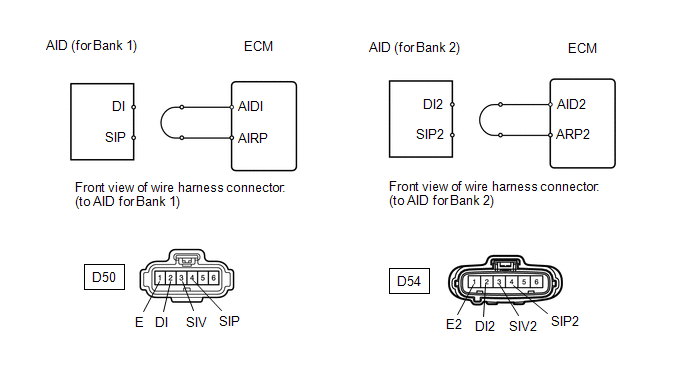 (k) Connect the Techstream to the DLC3.
(l) Turn the ignition switch to ON and turn the Techstream on. (m)
Enter the following menus: Powertrain / Engine and ECT / Utility /
Secondary Air Injection Check / Manual Mode / AIR PUMP 1: ON, ASV 1:
OPEN, AIR PUMP 2: ON, ASV 2: OPEN. HINT: When
Manual Mode is selected, the Techstream initialization (atmospheric
pressure measurement) is performed automatically. The initialization
takes 10 seconds. After the initialization, AIR PUMP and ASV operation
can be selected. (n) Start the engine. (o) Perform the AIR system forced operation while the engine is idling.
(p) Measure the voltage between the SIP and E or SIP2 and E2 terminals of the ECM connector when the AIR system is ON and OFF.
(q) Turn the ignition switch off.
NOTICE:
- Performing Secondary Air Injection Check repeatedly may cause damage to
the secondary air injection system. If it is necessary to repeat the
check, leave an interval of several minutes between System Check
operations to prevent the system from overheating.
- When performing the Secondary Air Injection Check operation after the
battery cable has been reconnected, wait for 7 minutes with the ignition
switch ON or the engine running.
- Turn the ignition switch off when the Secondary Air Injection Check operation finishes.
Standard Voltage: |
Tester Connection | Condition |
Specified Condition | | D50-4 (SIP) - D50-1 (E) |
AIR PUMP: ON, ASV: OPEN | 0.5 to 2 V | |
D54-4 (SIP2) - D54-1 (E2) | AIR PUMP: ON, ASV: OPEN |
0.5 to 2 V | | D50-4 (SIP) - D50-1 (E) |
AIR PUMP: OFF, ASV: CLOSE | 11 to 14 V | |
D54-4 (SIP2) - D54-1 (E2) | AIR PUMP: OFF, ASV: CLOSE |
11 to 14 V |
| NG |
 | REPLACE ECM |
|
OK |
 | |
| 14. |
REPLACE AIR INJECTION CONTROL DRIVER (FOR BANK 1 OR BANK 2) |
(a) Replace the air injection control driver (for bank 1 or bank 2) (See page
 ). ).
|
NEXT |
 | |
| 15. |
CHECK WHETHER DTC OUTPUT RECURS (DTC P2440, P2441, P2442 AND/OR P2443) |
(a) Start the engine and warm it up. (b) Turn the ignition switch off.
(c) Connect the Techstream to the DLC3. (d) Turn the ignition switch to ON.
(e) Turn the Techstream on. (f) Clear DTCs (if set) (See page
 ). ). (g) Enter the following menus: Powertrain / Engine and ECT / Utility / Secondary Air Injection Check / Automatic Mode.
(h) Start the engine after the Techstream initialization is finished. (i) Perform the System Check operation by pressing ENTER (Next).
(j) After operating the AIR system, perform the following to confirm the AIR system pending codes: Press the Exit button.
(k) Check pending DTCs. (l) Turn the ignition switch off. OK:
No pending DTC output.
NOTICE:
- When performing the Secondary Air Injection Check operation after the
battery cable has been reconnected, wait for 7 minutes with the ignition
switch turned to ON or the engine running.
- Turn the ignition switch off when the Secondary Air Injection Check operation finishes.
| OK |
 | END |
| NG |
 | REPLACE ECM |
| 16. |
INSPECT VACUUM HOSES (AIR SWITCHING VALVE - PRESSURE SENSOR) |
OK: No blockage and no deformation in vacuum hose.
| NG |
 | REPAIR OR REPLACE VACUUM HOSE |
|
OK |
 | |
| 17. |
INSPECT AIR SWITCHING VALVE ASSEMBLY (PRESSURE SENSOR) |
(a) Connect the Techstream to the DLC3. (b) Turn the ignition switch to ON.
(c) Turn the Techstream on. (d)
Enter the following menus: Powertrain / Engine and ECT / Data List /
Air pump pressure (Absolute) and Air Pump2 Pressure (Absolute). (e) Check the pressure displayed on the Techstream.
Standard pressure: 45 to 135 kPa HINT: The Techstream displays the air pump pressure as absolute pressure. Result |
Result | Proceed to | |
OK | A | |
NG (for Bank 1) | B | |
NG (for Bank 2) | C |
| A |
 | CHECK FOR INTERMITTENT PROBLEMS |
| B |
 | REPLACE AIR SWITCHING VALVE ASSEMBLY (FOR BANK 1) |
| C |
 | REPLACE AIR SWITCHING VALVE ASSEMBLY (FOR BANK 2) | |






